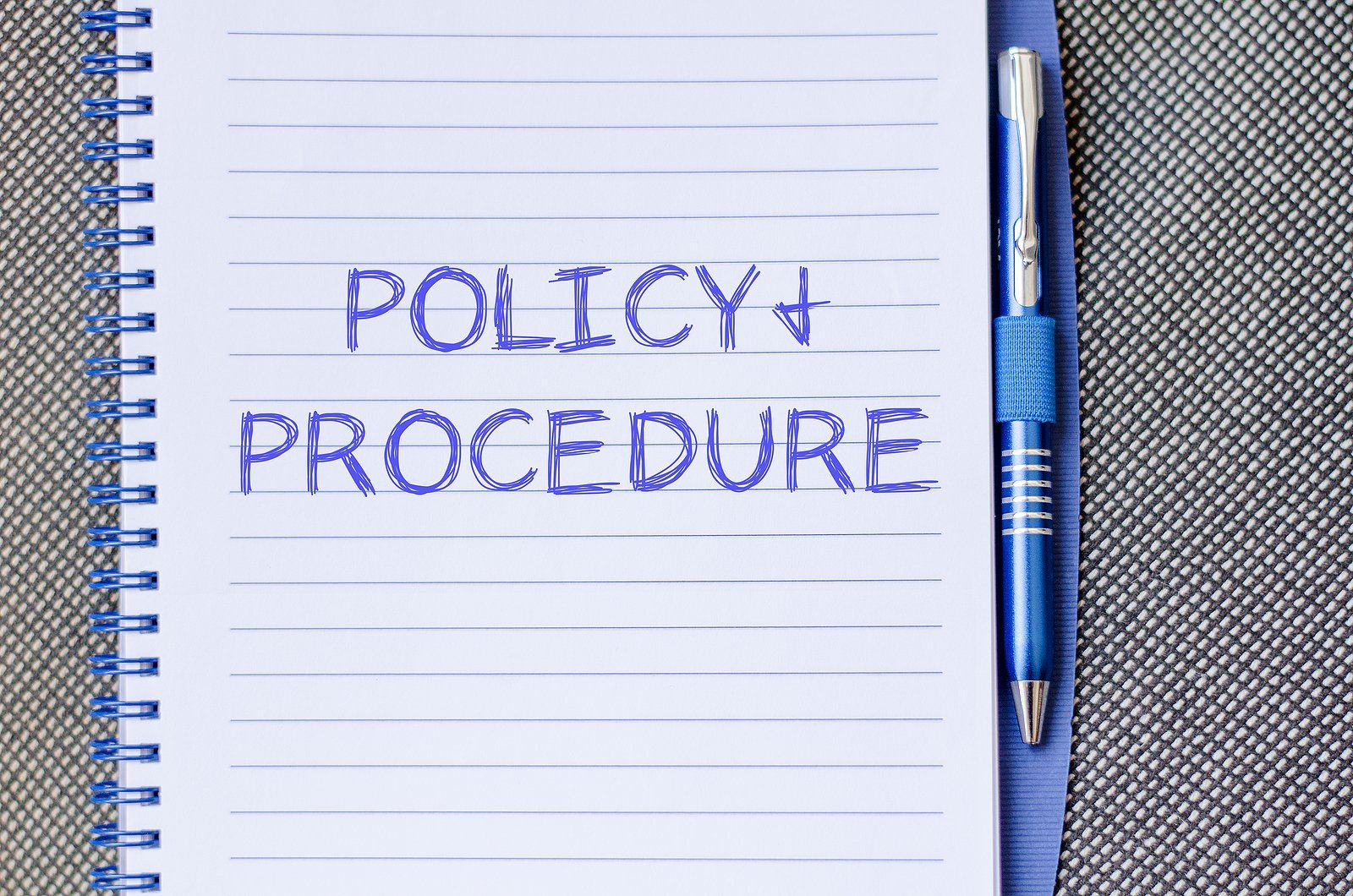Kenyon Connects
POLICY & PROCEDURES

When your survey is done, is there a collective sigh of relief at your agency? Is it because it was successful and you can continue as usual? Is it because you have so much to do and now you don’t have to be at the surveyor’s beck and call? Or, maybe your policy and procedure manual just got annihilated and you are going to have a huge plan of correction with an overhaul of your manual? The latter means we need to talk about fixing your manual and what way to do it. Do I Buy An Online Manual Or Fix Mine? Well, that truly depends on you and your business. If you only have a policy or two that gets cited, updating your manual may be a quick fix for your agency. This is normally the case if someone is routinely updating it and the manual is used to run your business. Ultimately, your agency needs to keep the document a living breathing manual or it will not serve its purpose. If your policy and procedure manual is not typically updated other than for survey, then you need to consider buying a manual. Your rule of thumb should be if your agency has not updated the manual within the last 3 years, you should consider purchasing a new one. There are many benefits to purchasing on online manual: Customization: Pick a manual that allows you to fully customize policies to fit your operations. You should not buy a manual that doesn’t provide this option. You need to be able to prove to the surveyor how your agency complies with the regulation. If the policy is written a certain way and you don’t change it to meet how you operate, you will still be cited. Forms/ Documents: Certain online manuals also provide forms that coincide with the policies. This makes it easy for you to implement changes because forms are already generated. There is no reason to reinvent the wheel by making your own. Most of these forms allow you to place your logo and any specific personalization within the document. · State Rules: Several vendors have incorporated specific state rules into manuals. For instance, Kenyon Homecare Consulting offers skilled, non-skilled and hospice manuals as well as ones that have incorporated California and Washington state rules. This eliminates the individual business having to go back in and add state rules to the manual. Consulting Services: Pick a vendor that also has consulting available should you need assistance in customizing your manual to meet your state rules or specific program rules. This makes the process easier especially if you are new to the policy writing and editing. Up-to-date: This is the biggest advantage. These manuals have been updated to include the rules you need. We have seen so many agencies over the last several years not keep up with COP changes and it cost them at survey and with compliance. These manuals are routinely updated with changes so when you purchase your manual it will have the current federal regulations. Ultimately, you have to decide whether it makes sense to rewrite your manual with updates or purchase one that is currently up-to-date. At Kenyon Homecare Consulting , we offer customizable manuals for all service lines, accreditation, and incorporated with certain state rules. Please call at 206-721-5091 or contact us online before purchasing your manual so we can ensure you have chosen the correct one to meet your needs. We also offer consulting services to help incorporate your state rules should you need assistance.

Over the years, Kenyon Homecare Consulting has been asked to provide nurse expert witness work in cases involving malpractice, fraud and abuse, and negligence. In the last several years, we have been most often asked to review cases involving wound care negligence and malpractice. So, consider your own wound care practices and decide if you are at risk of litigation or safe from malpractice. What We Normally See In Negligence Cases: The recurring theme in these cases is a patient who had a wound or develops a pressure ulcer that becomes infected and passes from sepsis. These patients are under the care of a home care, home health, or hospice provider. Let’s look at the list of things to consider in your clinical practice, operations, and documentation to assess your risks: Yes, we said hospice provider: Please note that the terminal status of the patient does not change the potential risk for litigation regardless of the patient being more susceptible to skin breakdown and to succumb to complications from it. Families expect the patient to pass from their terminal illnesses, but not to wound infection. This is always a potential blind spot for hospice agencies. If you have not followed your policies and maintained the proper documentation, then you will still lose a lawsuit even if there is nothing you could have done to prevent the development of the wound. Look at your policies: Are they up to date? We see a lot of policies with treatment now considered to be contraindicated. So, if you are sued and have policies that show you do things potentially detrimental to those in your care, you are at risk. A good example is the use of donut rings as a pressure reduction device. These are now known to cause pressure injury as opposed to prevent it. When you look at the topical treatment, is it synonymous with current industry standards for best practices? Does your policy show protocol for initiation of support surfaces when indicated? What about nutritional support and lab work to monitor nutritional status? If you aren't doing it, then don't mandate it in your policy. Procedures: This is the big one. If your policies are good, then you need to follow them. Now, this is true for everything in our industry, but when you have treatment and prevention measures in policy and do not follow what it says, you will likely lose the case. There are many cases settled because of agencies not following policies and procedures. The minute you are sued, everything about the provision of care goes under the microscope. You need to make sure policies are not so intricate that it is unrealistic for your staff to follow them. You also need to make sure clinical staff knows and understands your policy related to caring for these wounds. We have had cases where a nurse calls the physician and documents asking for the use of a certain treatment that is not in your protocol. Education/Assessment/ Documentation: Having a nursing degree does not mean every nurse can walk into every department and provide competent care in all situations. You cannot assume your nursing staff and therapists are skilled at assessment and know how to recognize the etiology of every wound if you have not provided the teaching. We have seen the documentation that lists a wound as a pressure ulcer and then the next week it is listed as venous stasis. If your staff is not skilled at defining what caused the wound based upon the characteristics, location, and patient medical background, you have not shown competency of staff to provide safe care to the patient. Documentation and interventions need to match the diagnosis. If you have a venous stasis ulcer and interventions are related to pressure relief, you are at risk. You may say this is something that does not happen at your agency, but we see it all the time. Who is responsible?: The answer needs to be everyone who sees that patient. This is often a responsibility delegated just to nursing, but this should never be the case. When you have a patient at risk for skin breakdown, every clinician needs to address it. This means every aide visit, every nursing visit, and every visit made by a therapist. When pulled into the courtroom, you will be asked why no one looked or documented on skin between nursing visits even through the patient had 2 aide visits and 2 therapy visits. You have no protection against the nurse documenting no skin breakdown last Monday but walking into a stage 3 pressure ulcer the next week. These are just some of the considerations for your agency when it comes to keeping your agency safe from a negligence claim related to wound care. At Kenyon Homecare Consulting , we focus on high-quality, patient centered care and helping your agency provide it. Call us today at 206-721-5091 or contact us online and let us help you and your agency achieve the outcomes you desire.

If you are getting ready for survey, then you realize having an up-to-date policy and procedure manual is key to avoiding citations. This means having all the necessary policies present to represent current regulations and to have your operations noted to show how you comply. Many times, agencies have one or the other, but not both. If you are considering buying a manual online instead of updating yours, then here is what you should know. Then, there is no reason to hold back. The Process To Buying An Online Policy and Procedure Manual: The first question to ask is how long it has been since yours has been updated? It’s not uncommon for us to see agencies with policies that have not changed over 20 years and now they have big issues at survey time. Here is what to do when looking to purchase a manual online: 1. Research your manual: Talk to the vendor looking to sell you a policy and procedure manual before you put anything in your online shopping cart. Many providers offer a multiple different manuals for different service lines. You need to make sure you purchase one that is accreditation ready if you need it. The accrediting bodies will review vendor’s manuals for accuracy. Before you buy, ask if the particular policy and procedure manual has been approved by the accrediting body. 2. Do you want your state rules incorporated? If so, then you need to find a vendor that provides it. If not, you will need to add them in yourself or pay a consulting service to make sure it is up-to-date. 3. Once it is purchased: You will have instructions from your provider. For instance, the template should allow you to type in your agency’s name one time and it populate throughout the manual. These things are important from the standpoint of ease to customize your manual. 4. Making the manual specific to your agency: Operations still need added to your policy. The manuals will have all the regulations incorporated into it. The one thing it will not contain is how your agency complies with the regulation. Anything policy that requires a process measure or needs to designate the person responsible for maintaining compliance will have to be added. This is the step agencies can’t forget when purchasing the manual. 5. Pull out what doesn’t apply and add what does: Don’t keep policies in your hard copy that don’t apply to your agency. You will also need to add things like your agency’s line of authority. You may see there is a line of authority policy in your purchased manual, but you need to alter it to fit the job titles in your agency. Let Kenyon Homecare Consulting Be Your Online Manual Vendor: At Kenyon Homecare Consulting , we have a comprehensive line of fully customizable online manuals for homecare/ private duty, home health, and hospice. We have accreditation and non-accreditation ready versions. We have several manuals with the state rules incorporated. If you want assistance to incorporate your state rules, then we have senior level consultants to assist. You can see our full of manual on our website here . Before purchasing, please call us at 206-721-5091 or contact us online to make sure you choose the right one to meet your agency’s needs.

When your policy and procedure manual is out-of-date, it really can seem like a never-ending abyss to clean it up. If it has been a long time since you thoroughly went through you manual, then consider whether to update a current one or buy a new one. Let’s look at some pros and cons of both. Update Your Policy And Procedure Manual Versus Buying A New One: Obviously, if you keep up on your policy and procedure manual, buying a new one is a moot point. As changes occur in regulations, you have updated policies accordingly. As operations change, you make the updates in your manual to match. Unfortunately, based upon our experience with agencies around survey time, this is not normally the case. We saw agencies who never updated manuals to reflect the COP changes in 2018. So, if agencies didn’t keep up with regulations to comply with the biggest changes to the Medicare program in 20 years, it is not shocking that the rest of the manual was outdated. It is not uncommon for us to be in agencies and see manuals that have some of the exact same policies in place from over 30 years ago. It is unrealistic to think that a large chunk of policies would remain the same if you are actively using your manual to assist in running your business. Too many things change in this industry. The result is many agencies got condition level deficiencies during that process. Some still aren’t truly in compliance. If you are in that boat, then the process of getting a very out-of-date manual up to par is time consuming and cumbersome. You really should consider purchasing a manual online that is complete with federal and potentially all your state regulations. If you have never ordered an online manual, then let’s look at the process and how it is the solution for so many agencies with non-compliant policy and procedures. Purchasing An Online Manual: First, always contact the vendor to ensure you are choosing the right manual for your business. Many vendors sell multiple service lines with and without state specific rules. Do not make the mistake and choose the wrong one by accident. You do not want to have to purchase a second manual if you bought the wrong one by mistake. These manuals come as a download to you normally in an email. You want one that is completely customizable online so you have the ability to tweak things along the way. Now that you have your manual, you need to begin the customization process. Agencies that purchase online manuals and do not edit them are just as much as risk for citations as those that are out-of-date. You need to go through the manuals which are completely up-to-date with regulations and add the specifics of how your agency complies with that policy. You need to add if a specific job title is responsible to carry out something in that policy. Some policies will not need anything changed, but you need to go through it and make sure. It is also a very good way to familiarize with regulations if you have become out of touch with them. If you bought a manual that only includes the federal regulations, then you will need to add anything state specific in order to comply as well. Kenyon Homecare Consulting Has Your New Online Manual Available Today! At Kenyon Homecare Consultin g, we have a comprehensive offering of manuals for homecare, home health and hospice. We offer accreditation ready and some with the state regulations included. Call us today at 206-721-5091 on contact us online to get your easy to customize manual today! Don’t waste a ton of time trying to resurrect and old manual because it will cost you a lot more than you think to get it ready for survey.

If you follow this blog, you have seen that lately we have focused on items specifically related to surveys and the citations in them. The reality is so much falls back on how your policies are written and carried out within your agency. When you look back at your last 3 surveys, how many had to do with policy error or lack of execution of a current policy? Let's look at some policy dos and don'ts and prevent there being an issue at your next survey. 5 Considerations For You Policy and Procedure Manual: Look at your policy manual objectively and determine if you have these 5 bases covered: Are all the regulations in there? Now, there is no quick way around this. Look at each regulation in your state for the service you provide. Can you link your policy back to each one? Many agencies will reference the exact state or federal regulation at the bottom of the policy or have an index of regulations with the corresponding page where that regulation can be found. Is every part of the regulation listed? Again, this is time consuming but you need to make sure all elements of the regulation are clearly stated. As we are on site with agencies helping with operations or survey prep, we see this all the time. 90% of the regulation is present and the other missing and now it is a citation. Methodically go down each regulation and if you can't find each element in your manual, then add it and get it approved by your board of directors. Does your manual clearly state how you follow policy? The elements of a clear and satisfactory policy not only state the regulation, but how your agency complies with it. Let's consider your complaints. Who manages them at your agency? Can anyone take a formal complaint or do you move it up the administrative chain to supervision? Who is responsible to sign off on resolution and document it? Do you follow your policies they way they are written? This often catches agencies by surprise, especially when a policy manual has been purchased but never edited. For example, let's look again at complaints. The surveyor asks about your complaint log and how you manage your complaints. As you speak to how a complaint is handled within your agency, it directly conflicts with your policy. You need to edit your manual to match operations. How often do you truly update your manual and who is responsible to keep it up-to-date? Some agencies have a designated person to update the policy and procedure manual when things change. Then, that person is responsible for communicating the changes to the board of directors and getting approval on the books. In other agencies, it is not as clear. Someone needs assigned the gatekeeper of monitoring regulatory change. Maybe your HR manager needs assigned changes related to OSHA and the clinical manager follows clinical changes and writes those changes. Maybe the CEO or administrator needs to be the gatekeeper for everything. Regardless, there has to be someone who is monitoring websites and state and federal guidance. Ultimately, your manual needs updated yearly and as regulation and your operations dictate. This requires a system of review and someone to evaluate if operations still match policy. Your manual needs to be a guide for anyone coming into your agency as to how it is run. If you had an interim manager in your agency, then it should be clear how you handle the clinical process from A to Z as well as personnel issues such as onboarding, discipline action, and reimbursement concerns. Kenyon Homecare Consulting Can Help: If you are getting ready for survey and realize your manual is so far out-of-date, you do not need to reinvent the wheel. At Kenyon Homecare Consulting , we have online manuals for all lines of service and we also have accreditation ready manuals if that is what you need. Call us today at 206-721-5091 or contact us online so see which manual meets your needs. Our manuals can be downloaded directly from our website.

In consulting throughout different agencies within the US, we have seen so many different ways home health and hospice agencies operate. The thing that remains consistent and clear in all of them is that when policies and procedures do not match operations, there is always an issue. Let’s look at common things we see and where they can be landmines for agencies on a day-to-day basis. 7 Operational Landmines: When we talk about landmines, we could mean with personnel issues, financial success, clinical practice, legal compliance, or at survey time. Having solid policy and procedures and operating manuals should be a sure guide to running your agency. In some cases, policies are not even considered as a tool. Here are 7 of the big landmines we see in agencies: Complaint Follow Up: When the state or accrediting body follow up on a complaint, will you be able to show adequate follow up and follow thru? Does your agency all agree on what is written up as a complaint? Do staff know and understand your complaint policy. Do they follow it? Personnel Issues: The biggest landmine here is if you don’t follow your own policy. You can’t provide 2 different kinds of disciplinary action to employees for the same offense in your manual. You may be on the hook for a lot more unemployment if you do. Reimbursement/ Compensation: Same applies here. Wages and compensation must follow the same pattern for the employees. Your policies need to be clear as to what you will and won’t pay an employee for or you will end up paying for it all. Labor Disputes: You have to know and follow labor laws. Make sure your policies match what is required on the federal and state levels. Withholding Wages: This is a very slippery slope for us in the industry. In institutional settings, the employee finishes the shifts documentation before clocking out for the day. In home health, this may be best practice and what you want as a business owner, but it doesn’t always happen. Frustrated administration can say that if documentation isn’t turned in, then you don’t get paid. Be careful though, depending upon where you are, you may not be allowed to do so. Continuity In Branches: Regardless the size of your agency, the way they run needs to match. You can’t have discrepancies between how office managers or nursing supervisors handle operating issues. Hiring Practices: This one is huge. Not only are there legal components but also retention and financial implications as well. Your processes need to be swift and have continuity in the process of interviewing and onboarding. You already have to spend so much time and money to recruit and retain employees, but have you looked to see if you miss the mark from the minute you receive the application? Keep Your Manuals Updated Routinely: At Kenyon Homecare Consulting, we want to help you see policies and procedure as a tool and not a hindrance to smooth operations within your agency. We have fully customizable online manuals for all business lines and accrediting bodies. Call us today at 206-721-5091 or contact us online with any questions you may have about our services or online manuals. Please also consider joining us February 24th for our free webinar “Are You Afraid To Ask Who’s Minding The Store? Ensure Operational Efficiencies by Making Sure All Arms Of The Business are Efficient and in Compliance” at 10 am PST. Register today!

The surveyor walks through the door. What is one of the first thing he or she asks to see? That’s right. It’s the policy and procedure manual. When’s the last time yours was updated? Do you utilize it frequently in running your business? Or, is it something you purchased and never touched. Either way, it gets you in trouble at survey time over and over. So, isn’t it time to make it work for you and not against you? Things To Consider With Your Manual: Here are the list of essential things to consider when you look objectively at your manual: State And Federal Regulations: Who in your organization keeps abreast of regulatory changes? When was the last time your manual was truly reviewed from beginning to end? Who Is Responsible to Update The Manual? Who in your organization is assigned to update your master manual when things change? Is there someone routinely doing it? Does Your Manual Guide Your Operations? If yes, then you probably have a manual that is more up-to-date than most. Does You Manual Actually Put You At Risk? Consider employees and whether the personnel decisions you make consistently follow policy. In many cases, it does not. This can be a huge problem especially if branch locations handle the same personnel decisions differently. Did You Purchase Your Manual? Online manuals are fantastic because they contain up-to-date federal regulations. Depending upon your state, some companies offer state specific rules as well. Many agencies forget to add the state regs into their online manual. However, the biggest mistake agencies make is when they do not customize these manuals to fit their operations. For example, the online manual you purchased may have a great emergency preparedness plan, but you didn’t do a hazard risk assessment or make the interventions specific to what your agency does. Make sure you purchase accreditation ready manuals if this is the route you are going. Helping You On The Federal And State Level: At Kenyon Homecare Consulting, we have online manuals available for purchase for all lines of in-home services. We also offer state crossovers for several states. If you are looking for help to add state rules into your manual, our senior level consultants can help you do so. Whether you are starting a new agency or are an existing one, we can help get your manual up-to-date and survey ready. Make it the tool it was meant to be. Call us at 206-721-5091 or contact us online to see how we can help you.this default text and start typing your own or paste your own from a different source.
